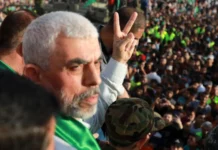Abdel Rahman al-Jamal, a 63-year-old veteran member of the Gaza legislative council, is deeply entrenched in Hamas’s apparatus and has played a central role in the recent hostage crisis.
In his book “Lexicon of the Hamas Movement,” Guy Aviad, an expert on Palestinian terrorist organizations and Israel’s military history, says al-Jamal was born in the Nuseirat refugee camp. He began as a student of Islamic law before earning a doctorate and eventually serving as the dean of religious studies at Gaza’s Islamic College.
While not an official member of Hamas’s “military” wing, al-Jamal stands accused of coordinating terrorist attacks by the wing against Egyptian forces in Sinai after meeting with the movement’s leader Khaled Mashaal, according to an Egyptian indictment.
His extended family, closely tied to the Hamas regime, is a wealthy clan owning several properties in Nuseirat, including the home where three of the four Israeli hostages rescued last Saturday were held captive for months.
The al-Jamal family’s civilian hideout
One of the homes belonging to al-Jamal’s clan became the place of captivity for Andrey Kozlov, Almog Meir Jan and Shlomi Ziv. The house is owned by a relative, Abdullah Talib al-Jamal, a former journalist for the Hamas-affiliated Palestine Now news agency who had an article published in Al Jazeera.
Abdullah’s 74-year-old father, Ahmed Youssef, previously served as a senior adviser to former Hamas leader Ismail Haniyeh and maintains ties to the current leadership, illustrating the family’s prestige and connections within the regime.
For half a year, Hamas terrorists took over the upper floor of this spacious al-Jamal family home in Nuseirat, holding the three hostages under armed guard.
As reported by The Wall Street Journal, the captives were confined to a single room with thin mattresses to sleep on, passing time playing cards and learning Arabic. Kozlov, a recent Russian immigrant to Israel, also learned Hebrew. Access to television was rare, and any violation of the strict rules imposed by their captors resulted in punishment, including confinement in the bathroom and threats of execution.
Throughout this ordeal, the al-Jamal family members, children included, continued residing on the lower floor of the house, where the kitchen was located. On one occasion when the family left, the hostages were permitted to use the kitchen facilities. When Israeli forces eventually stormed the home to free the captives, Abdullah, his father, and wife were killed in the operation.
An IDF statement following the raid highlighted how “the hostages were held alongside Abdullah’s family members in his family’s home,” condemning it as “further evidence that the Hamas terror organization uses the civilian population as human shields.”

This tactic extended to Noa Argamani, another hostage rescued from an apartment 200 meters away from the al-Jamal residence.
Images of the room where she was held, circulated on Arab social media, revealed a closet, bed and two dolls—small comforts amid the harsh conditions she endured while confined for months and forced to remain silent to avoid angering her captors.
Argamani later said the house belonged to a wealthy Nuseirat family who told her she was fortunate to be held by them rather than others, suggesting that the al-Jamal clan may have been involved in that holding location as well.
Hamas’s extensive civilian hideout network
The al-Jamal clan’s role in the hostage crisis exemplifies how Hamas exploits Gaza’s civilian population to further its “military” objectives. While the terrorist group’s indiscriminate use of human shields is well-documented, the recent hostage crisis reveals a new depth of depravity in embedding captives within civilian homes and neighborhoods.
As captives have been freed or rescued, their testimonies, coupled with insights from security officials and analysts, have gradually exposed Hamas’s modus operandi of concealing hostages at the heart of Gaza’s civil society. The rescue operation’s success, despite Israel’s lacking a physical intelligence presence in Gaza for two decades, underscores the terrorist group’s effectiveness in this regard—at least initially.
Hostages reported being shuttled between hideout apartments during their captivity, occasionally transported in ambulances or disguised in traditional Arab attire to avoid detection.
Argamani recounted encountering other captives such as Itay Svirsky and Yossi Sharabi, who were murdered in captivity, during these transfers. Meir Jan corroborated that he, Kozlov and Ziv were repeatedly moved between hiding apartments by their Hamas captors.
Some hostages, like the Marman and Leimberg families abducted from Kibbutz Nir Yitzhak, were held in vacant apartments with no residing families
Mia Leimberg, 17, held in Gaza for 53 days, described being kept on the second floor of a Rafah home that had been evacuated, surrounded by a “civilian neighborhood” with the “voices of vendors and children” audible from the streets.
“The neighborhood was full of Hamas people, and those who guarded us were terrorists,” Leimberg recounted. “The terrorists told us not to make noise because if they heard us, they would come and murder us.”
The constant sounds of IDF bombings heightened her terror, as she feared the building’s collapse would expose their location, resulting in mob violence or execution by their captors.
Released captives like Leimberg aided the IDF’s subsequent operation to extract the remaining hostages in that Rafah apartment, Luis Herr and Fernando Simon Marman.
“We were in an apartment of a family in Rafah, on the second floor, but the family wasn’t there, only our guards,” Herr recalled. “We heard people’s voices and mostly the bombings from the IDF. It was clear there was a war between Israel and Gaza.”
Hamas’s trusted civilian confidants
This extensive network of civilian hideouts stems from Hamas’s longstanding embeddedness within Gaza’s social fabric, having originated as a grassroots movement before evolving into a terrorist entity and de facto government.
Over the years, the group has developed operational procedures for concealing operatives in designated apartments amid the general population, extending this protocol to hiding kidnapped Israeli soldiers such as Nachshon Wachsman and Gilad Shalit.
Shalit, who was kidnapped to Gaza in 2006, was held for five years in hiding apartments in the Strip. He was guarded by an isolated group of Hamas terrorists who were part of the organization’s “shadow unit.”
This is a very small group, completely cut off from the world, whose job is to guard prisoners 24/7 for an extended period,” Aviad said. “It’s a focused group of professional terrorists whose job is this.”
However, the “shadow unit” members, like hiding apartments, are a limited resource. It seems that ahead of Oct. 7, Hamas prepared a plethora of hiding apartments and detention facilities in tunnels throughout the Strip.
As for the families entrusted with “hosting” captives in their homes, they are meticulously vetted based on multigenerational ties and absolute fealty to Hamas’s ideology, often cemented through marriages.
“These are connections that go back years, and as a result, trust develops between the sides, which is the key word here,” explained Harel Chorev, a historian tracking Hamas networks. “Hamas is heavily embedded within the population, usually through certain families identified with it. … Once Hamas managed to penetrate this space, it became an inherent part of the identity of those clans.”
While some experts suggest intimidation plays a role, most assert genuine ideological belief and loyalty take precedence.
“Apart from the loyalty and belief in Hamas’s path, that family father knows that if he doesn’t cooperate with Hamas, they’ll separate his head from his body,” noted former Israel Security Agency (Shin Bet) coordinator Adi Carmi. “And yet, in my opinion, fear is the least significant component. The main component is trust.”
However, researcher Ronit Marzan offers a different perspective, portraying Gaza’s civilians as hostages themselves under Hamas’s oppressive rule.
“Gaza residents who have fled say that anyone left in Gaza has no choice but to cooperate with Hamas and remain silent,” she said, citing reports of brutal reprisals against entire families for any dissent, including torture, imprisonment and denial of healthcare and jobs.
Overcoming intelligence obstacles
The use of trusted civilian confidants to hide captives significantly impeded Israeli intelligence efforts to locate the hostages.
“People who are ostensibly uninvolved and not known as operatives of the military wing are people the Israeli intelligence may not necessarily be familiar with,” Carmi acknowledged. “And indeed, we see that this method works.”
For two decades following Israel’s 2005 withdrawal from Gaza, the Shin Bet lacked a physical presence in the territory, relying primarily on signals intelligence. However, the widespread ground operation during the recent conflict enabled human intelligence gathering through interrogations and local sources, allowing the agency to gradually piece together the hostages’ likely locations.
Carmi continued, “After the IDF entered the area, the Shin Bet began striving for contact, until eventually it succeeded in locating where the captives were being held. Once you start arresting people, interrogating them and operating them, you learn the area at a much higher resolution.”
It is crucial to note that the “strategic” captives who remain in Hamas’s grip are IDF soldiers seized during combat operations, including the observation officers from Nahal Oz. According to Shin Bet officials and security experts consulted, these prisoners represent Hamas’s final bargaining chips, which the group will be highly reluctant to relinquish to Israel.
Unlike the hostages held in civilian homes, it is likely that these captive soldiers are not being detained above ground, but rather in designated subterranean facilities Hamas constructed specifically for this purpose. These holding sites are believed to be located deep within the tunnel networks underlying Rafah and Khan Yunis.
Consensus among the officials indicates that the living conditions endured by these captive military personnel are considerably harsher than those experienced by hostages sheltered in residential dwellings above ground.
Thus far, the sole female soldier rescued from Hamas captivity through a military operation is Ori Megidish, who was extracted from within Gaza during the early stages of the war. However, according to some sources, even Megidish was not held in a tunnel complex, but rather in a private home.
Originally published by Israel Hayom.


























